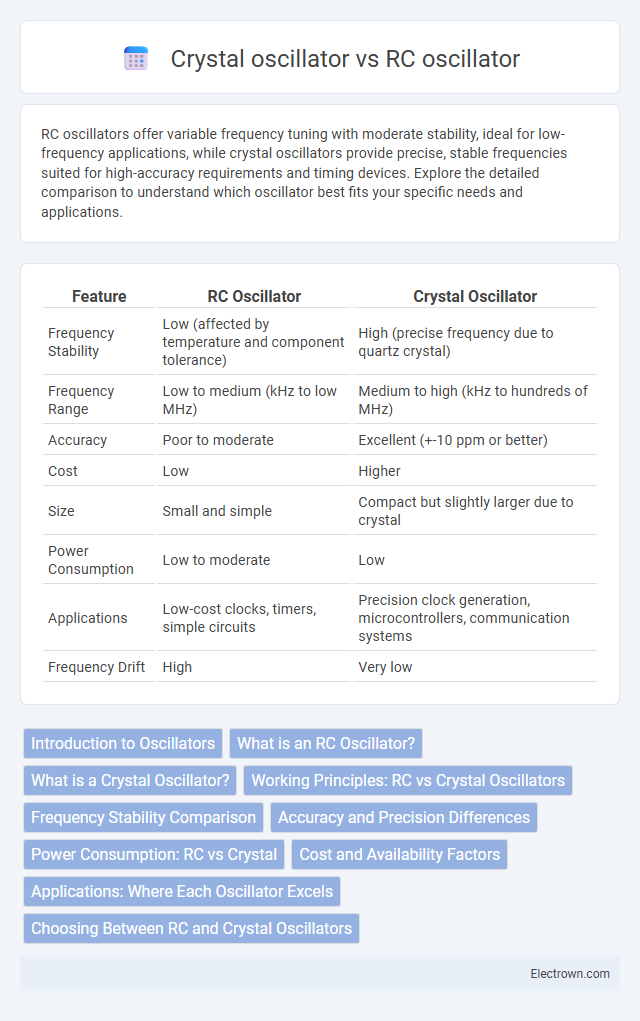RC oscillators offer variable frequency tuning with moderate stability, ideal for low-frequency applications, while crystal oscillators provide precise, stable frequencies suited for high-accuracy requirements and timing devices. Explore the detailed comparison to understand which oscillator best fits your specific needs and applications.
Table of Comparison
| Feature | RC Oscillator | Crystal Oscillator |
|---|---|---|
| Frequency Stability | Low (affected by temperature and component tolerance) | High (precise frequency due to quartz crystal) |
| Frequency Range | Low to medium (kHz to low MHz) | Medium to high (kHz to hundreds of MHz) |
| Accuracy | Poor to moderate | Excellent (+-10 ppm or better) |
| Cost | Low | Higher |
| Size | Small and simple | Compact but slightly larger due to crystal |
| Power Consumption | Low to moderate | Low |
| Applications | Low-cost clocks, timers, simple circuits | Precision clock generation, microcontrollers, communication systems |
| Frequency Drift | High | Very low |
Introduction to Oscillators
RC oscillators use resistors and capacitors to generate oscillations with frequencies typically in the low MHz range, making them suitable for applications requiring moderate frequency stability. Crystal oscillators rely on the piezoelectric properties of quartz crystals to produce highly stable and precise frequencies, often used in clocks, radios, and communication devices. Compared to RC oscillators, crystal oscillators provide superior frequency stability and accuracy, essential for precision timing and frequency control.
What is an RC Oscillator?
An RC oscillator uses resistors and capacitors to generate a periodic signal, typically producing lower frequency sine waves ideal for audio and low-frequency applications. Its frequency stability is generally lower compared to crystal oscillators due to component tolerances and temperature variations. RC oscillators are favored for cost-effective, simple, and tunable oscillation in circuits where precision timing is not critical.
What is a Crystal Oscillator?
A crystal oscillator uses the mechanical resonance of a piezoelectric crystal, typically quartz, to generate a precise and stable frequency signal. It offers superior frequency accuracy and low phase noise compared to RC oscillators, which rely on resistors and capacitors. Crystal oscillators are essential in applications like clocks, radios, and communication devices where high stability and precision are critical.
Working Principles: RC vs Crystal Oscillators
RC oscillators generate oscillations using resistors and capacitors to create a phase shift network that provides the necessary feedback at a particular frequency, relying on the charging and discharging of capacitors. Crystal oscillators operate based on the piezoelectric effect of quartz crystals, where the crystal's mechanical vibrations produce a highly stable and precise oscillation frequency. The quartz crystal's resonant frequency sharply defines the oscillation frequency, making crystal oscillators significantly more frequency-stable than RC oscillators.
Frequency Stability Comparison
RC oscillators exhibit lower frequency stability due to their sensitivity to temperature variations and component tolerances, causing drift over time. Crystal oscillators provide superior frequency stability by utilizing the piezoelectric properties of quartz crystals, ensuring minimal frequency deviation even under varying environmental conditions. Your choice depends on the required precision, with crystal oscillators being ideal for applications demanding high stability.
Accuracy and Precision Differences
RC oscillators typically exhibit lower accuracy and precision due to their reliance on resistors and capacitors, which are sensitive to temperature variations and component tolerances. Crystal oscillators use quartz crystals that provide highly stable and precise frequency control, making them ideal for applications requiring stringent timing accuracy. Your choice should consider that crystal oscillators maintain frequency stability within parts per million, outperforming RC oscillators that often drift by several percent.
Power Consumption: RC vs Crystal
RC oscillators consume significantly less power compared to crystal oscillators, making them ideal for low-power, battery-operated devices. Crystal oscillators, while more accurate and stable, require more current to maintain oscillation due to the quartz crystal's mechanical resonance. Your choice should balance power efficiency needs against frequency stability requirements for the specific application.
Cost and Availability Factors
RC oscillators are generally more cost-effective and widely available due to their simple construction using resistors and capacitors, making them suitable for low-frequency applications where precision is less critical. Crystal oscillators, while more expensive and requiring precise quartz crystals, offer superior frequency stability and accuracy, limiting their availability to specialized vendors and applications demanding high precision. The cost difference stems primarily from the materials and manufacturing complexity, with crystal oscillators often being less affordable for mass-market, low-cost electronic devices.
Applications: Where Each Oscillator Excels
RC oscillators excel in applications requiring low frequency stability and cost-effectiveness, such as audio signal generation, simple clock circuits, and timing in consumer electronics. Crystal oscillators are preferred in high-precision applications like communication systems, microcontrollers, and instrumentation, where frequency stability, low phase noise, and accuracy are critical. Their superior frequency stability and low thermal drift make crystal oscillators ideal for RF circuits, GPS devices, and frequency synthesis.
Choosing Between RC and Crystal Oscillators
Selecting between RC and crystal oscillators depends on the required frequency stability and application context. Crystal oscillators provide superior frequency accuracy and stability, typically within a few parts per million, making them ideal for precise timing in communication systems and microcontrollers. RC oscillators offer lower cost and simpler design but suffer from wider frequency tolerance and temperature sensitivity, suited for less critical timing tasks and cost-sensitive applications.
RC oscillator vs crystal oscillator Infographic

 electrown.com
electrown.com